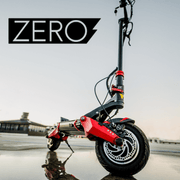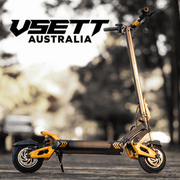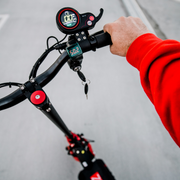Are you ready to embrace the future of commuting and adventure with an ebike in 2024? The world of e-bikes has evolved, offering a diverse range of models to suit various preferences and needs. In this guide, we'll help you choose the right electric bike from Ride Electric's collection by explaining important factors to consider.
What Constitutes an Electric Bike According to Australian Law?
Under Australian regulations, an electric bike is defined by the Australian Vehicle Standards as a bicycle equipped with an auxiliary motor, where the maximum power output does not surpass 250 watts, without consideration for speed limits or pedal sensors.
Australian electric bikes are categorized into two groups:
- Power Assisted Pedal Cycles (maximum 200 watts)
- EN15194 Certified Power Assisted Pedal Cycle (Pedelec, maximum 250 watts)
- Non-EN15194 certified electric bikes must not exceed 200 watts, and the motor should be limited to 25 km/h.
- Certified pedelec electric bikes should not surpass 250 watts, and the motor speed is capped at 25 km/h.
- They must be propelled by human pedal movement (no throttles), although some states permit throttle-driven bikes on private property.
- At the moment, all states concur that ebikes do not necessitate licensing or registration.
Ebikes exceeding the prescribed power and speed limits are considered road vehicles. Consequently, riders must adhere to distinct legal requirements in different states and territories when using public roads.
Conventional Bicycles vs Electric Bikes
The most evident distinction between a traditional pedal-powered bike and an e-bike lies in the integration of the electric drive system. Brands have designed this system to feature a lighter and more compact battery and motor, progressively aligning it with the standard pedal ones. While comparing a regular road bike to an electric bicycle reveals numerous similarities, a closer inspection also reveals many differences.
One notable difference is in the construction of the bicycle. Due to the increased power output and driving force of ebikes, they typically boast robust builds.
They commonly feature specially designed frames, reinforced forks, and components crafted to withstand the additional power and load they deliver. Consequently, electric bikes tend to be heavier than standard bikes, often weighing over 18kg without factoring in additional essentials such as panniers, water bottles, and tools.
1. Understanding Your Riding Style
Electric bikes come in various styles, each designed for specific purposes. Before making a decision, consider how and where you plan to use your ebike:
Commuter Bikes:
Overall, mid-drive motors offer a smoother and more stable ride, which can feel more natural when pedaling. The majority of electric bike models come with pre-set assistance levels, ranging from basic modes that mimic a regular bike to powerful modes that effortlessly handle steep slopes. Generally, these assistance levels consist of the listed settings, and occasionally additional ones.
If your primary goal is daily commuting, making your trips easier and still nicer, look for models like the Smartmotion MidCity or the Xurban Neo, known for their ergonomic design, long battery life, and smooth performance in urban environments.
Commuter ebikes help the environment and keep you away from the annoying traffic.
Mountain Bikes:
For adventure seekers and trail lovers, Ride Electric offers powerful electric mountain bikes such as the Smartmotion Hypersonic Neo and the Xplore, equipped with robust suspension systems and durable frames to conquer challenging terrains.
These models not only offer the best components in the market, but they are also very affordable when compared to other electric mountain bike brands out there.
Folding Bikes:
Need a compact solution for easy storage? Explore models like Smartmotion E20 or Mamba Taureg with folding mechanisms. They are foldable electric bikes that combine portability with cutting-edge technology and style.
They are perfect to store under your desk at work, to take with you on public transportation, or to take on a trip.
Fat Tyre Bikes:
If you are looking to dive into a world of off-road exploration, but also want a stylish bike to commute and turn heads everywhere you go, look at Fatfish or Mamba Sahara fat tyre bikes.
Featuring oversized, all-terrain tyres these ebikes ensure stability and traction on sand, snow, and challenging trails. They combine the thrill of adventure with the convenience of electric power, making them an ideal choice for riders seeking some excitement.
Dirt Bikes:
These models represent the epitome of off-road excitement and adrenaline-fueled adventures.
Engineered for rough terrains, these dirt bikes, including popular models like the Surron, are crafted to withstand the challenges of dirt trails and provide an unmatched riding experience.
The powerful electric motors deliver instantaneous torque, ensuring quick acceleration on your trail riding and dynamic manoeuvrability on unpredictable surfaces.
For those who seek the thrill of off-road riding and crave the responsiveness of cutting-edge technology, investing in a dirt bike is not just a purchase; it's a commitment to embracing the untamed spirit of adventure.
2. Battery Life and Range
The heart of any electric bike is its battery. Whether you're commuting or going on a long weekend ride, having a reliable battery range is crucial for a seamless experience.
Consider your intended usage for it. If you plan on taking long-distance rides with high assistance, keep in mind that this will demand more battery power, although it's important to note that power is limited to 250 watts unless used on private property.
Similar to other engines, greater torque equates to more power and an enhanced boost to your pedaling. Many models offer additional features like a range extender or supplementary battery to prolong the bike's operation.
Charging a depleted battery is typically straightforward for most models, with the charging time contingent on the amperage and battery capacity. Generally, an electric bike battery will last through over a thousand discharges before necessitating replacement.
3. Motor Power
The motor determines how smoothly your electric bike operates.
Electric bicycles typically come equipped with either a hub motor or a mid-drive motor. A hub motor can be found in either the front or rear hub of the wheel, while a mid-drive motor is positioned at the crank area, transferring power to the chain and subsequently propelling the wheel.
In general, mid-drive motors provide a more comfortable and balanced riding experience, that can feel more natural as you pedal.
Most e-bike models come pre-programmed with various levels of assistance, ranging from standby levels where it operates like a traditional bicycle, to high assistance levels that efficiently tackle steep gradients. Typically, these assistance levels include the following settings, and sometimes more.
Assistance Modes
No Assist: The bicycle will function without any assistance.
Economy Mode: This mode provides support ranging from 25-80% of the maximum assistance, making it well-suited for extended rides with a focus on achieving greater range.
Normal Mode: Standard assistance levels are offered in this mode, matching 100-150% of pedaling output and delivering noticeably increased torque.
High Mode: This mode delivers assistance surpassing 200% of pedaling output, making it perfect for effortlessly conquering steep hill climbs. However, the heightened power output may potentially reduce the bike's range in certain situations.
4. Frame Material and Design
Consider the frame material for durability and weight.
Nowadays, top-notch electric bikes provide robust torque without significantly increasing weight or occupying excessive space on the bike frame. Cyclists generally understand that, when it comes to bike weight, a lighter is usually better, as it enhances maneuverability and handling.
Electric bikes inherently weigh more than standard bicycles due to the added components like motors and batteries. Nevertheless, there are still models available that achieve substantial assistance while maintaining a surprisingly low weight.
In general, electric bikes range in weight from 15 to 30 kilograms. When deciding on the optimal weight for your needs, consider the specific style of electric bike you're interested in.
Road bikes designed for covering long distances at high speeds tend to be lighter. On the other hand, fat tyre electric bikes and those crafted for off-road adventures may have a bulkier design to handle more rugged terrains.
Portability and convenience also play a role. If you anticipate carrying it, opting for a lighter design might be worthwhile. For situations where you need to transport the bike on public transit or store it in tight spaces, a folding bike could be an excellent choice. However, if your primary use involves commuting over long distances, the additional weight from a high-capacity battery may be a worthwhile compromise, as the electric motor facilitates easier pedaling despite the increased weight.
5. Ebike Tyres & Wheel Size
They come in a wide variety of wheel and tyre sizes, and the ideal size for you depends on your specific needs and intended use. Most e-bikes are equipped with wheels of 16, 20, or 26 inches in diameter.
Smaller to mid-sized wheels are commonly found on commuter and folding bikes, designed for compactness and lighter weight. However, smaller wheels may lead to a jolty feel when encountering potholes or uneven surfaces during urban riding.
Larger wheels offer a smoother ride and can contribute to longer battery life by maintaining momentum more effectively. They also provide increased stability, traction, and durability. However, larger wheels may feel less maneuverable and transfer torque to the ground more slowly than smaller wheels due to the larger frame size, reducing the force applied to the ground.
6. Ebike Rules and Regulations
Once your e-bike or e-scooter exceeds the legal speed limit of 25 km/h, it is no longer classified as an electric bicycle under Australian law. Instead, it is considered a road vehicle comparable to a moped or motorcycle, subject to distinct legal requirements for each state and territory when using public roads.
Additional regulations, varying by state, include wearing a helmet, enhancing visibility through high-visibility clothing and lights at night, maintaining your tyres pumped up, refraining from riding under the influence of alcohol, and utilizing a warning device like a bell or horn. Familiarizing yourself with specific rules and regulations for your location is essential.
7. Budget Considerations
Electric bikes in Australia vary in price, and it's essential to set a budget before exploring options. Ride Electric offers a wide range of models at different price points, ensuring you find one that suits your needs without breaking the bank.
$1k - $2k
This price range is accessible to individuals seeking entry-level commuter e-bikes. Generally, electric bikes within this price bracket are equipped with hub motors rather than Pedelec, as hub motors have a simpler design and are more budget-friendly. While the components on more affordable e-bike models may be relatively basic, they serve as an excellent choice for new riders seeking the electric bike experience without a substantial financial commitment.
$2k - $4k
This price category includes both entry-level offerings and mid to high-end models positioned at the upper limit of the price spectrum. This price range is typical for a standard Pedelec e-bike, although there are also high-quality hub motor designs available within this bracket. Once more, the majority of models in this range are geared towards commuter use.
$4k - $5k
The models in this range typically come with additional accessories, larger-capacity batteries, and higher-quality components. This price range is associated with top-tier commuter e-bikes and aligns with the cost range for entry and mid-level electric mountain bikes and electric road bikes.
Over $5k
Above the $5,000 mark, you'll find the most luxurious electric bike models, including mountain biking, dirt biking and road biking. In this price range, anticipate a top-notch Pedelec motor, advanced high-capacity battery systems, lightweight and durable constructions, along with additional technical features. Premium electric mountain bikes, in particular, can surpass the $5,000 threshold by a significant margin, delivering exceptional suspension systems and specialized components.
8. Maintenance
Maintaining your electric bike is crucial for its prolonged smooth operation and longevity. While e-bike maintenance is generally manageable, adhering to routine checks, proper storage practices, and regular servicing is essential to maximize the lifespan of your electric bike.
How often should an e-bike be serviced?
Similar to a conventional bicycle, they should undergo servicing twice a year. During these service sessions, an expert will meticulously inspect the bike for any mechanical issues and update the firmware.
If you are in Brisbane or Gold Coast, our top-notch team of mechanics will be more than happy to assist with your regular service at our Ride Electric Servicing.
What pre-ride checks should be performed?
Before going on a ride, conduct brief mechanical and electrical checks to avoid potential issues on the road. Verify tyre pressure, as under-inflated tyres can drain the battery more quickly. Ensure the brakes are in proper working condition. Additionally, make sure that your battery is fully charged or has enough charge to reach your destination.
Other maintenance tips:
- Keep your e-bike chain well-oiled and replace brake pads as needed.
- Familiarize yourself with your route to plan for various assistance levels and optimize battery usage.
- Avoid letting your battery completely discharge before recharging.
- Refrain from disassembling your battery or motor system, as this could result in injury and void your warranty.
- Handle the cables with care to prevent damage.
- When cleaning your bike, avoid directing water hoses directly at electrical components.
- Store it in a clean, dry environment.










